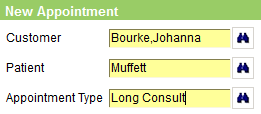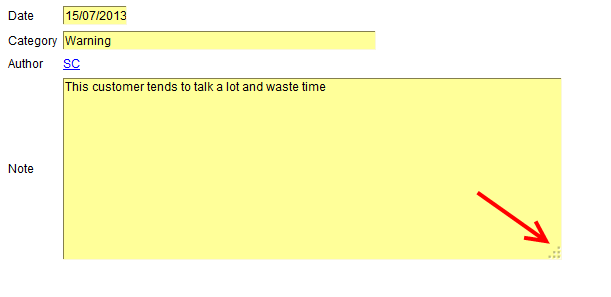Data Entry
Below are various things that need to be understood when entering data into OpenVPMS.
The headings in this section are Data Validation, Data Search, Macros, Spelling, Dates, The Enter Key, Propercase, Note Fields, and Tab Edits.
Data Validation
For various data fields (eg species, breed), you cannot enter any value, you must select a value from a pull-down list. Click the field or its down-arrow and then click on the required value, or type the first letter to display the allowed values starting with that letter. You can also use the up and down arrow keys, the page up and down keys, and the home and end keys to navigate up and down the list of items.
Your administrator can add new values using the Administration|Lookups facility.
Data Search
Where you see the binoculars icon after a field like the following
 this means that the data search facility is available. This makes it easy to find things (in this case a product). You proceed as follows:
this means that the data search facility is available. This makes it easy to find things (in this case a product). You proceed as follows:
- Type in as much as you want (using wildcards if needed), and then either click the binoculars, or press Enter. 'b' will find all the items starting with 'b'; 'bon' those starting with 'bon', 'b%pl' those starting with a 'b' and with 'pl' somewhere in the name. Note that the case does not matter, ie 'b' or 'B' will both find items starting with 'B' or 'b'.
- If there is more than one matching item, then a select screen will be displayed showing the matches. If what you want is not there, you can adjust the selection parameters on the select screen and press its Find button.
You then click the required item and you will be returned to the data entry screen with the item filled in. - If there is only one matching item, then the select screen will not be displayed, and the name of the matching item will be filled in. For example, if only 'Bone Plate 6 Hole' matches 'b%pl', then 'Bone Plate 6 Hole' will immediately replace the 'b%pl' you typed.
- If there are no matching items, the select screen will be displayed with what you entered showing in its Search field. Adjust what you typed, eg 'bonr' to 'bone' or 'bon' and press Enter to do the search.
In fact, you don't need to press the Enter key or click the binoculars. When you complete your data entry by using the Apply or OK buttons, the system will check for any incomplete entries and process them. For example, on the New Appointments screen there are three fields with binoculars. You can fill in each with an abbreviated form of the entry and then press OK or Apply. If your abbreviations match only single items, then the three entries will be automatically completed. As an illustration, on the system used to create these examples, there is only one customer with a name starting 'bo', and she has only one pet with a name starting with 'm', and there is only one appointment type starting with 'l'. Hence, entering bo, m, and l in the three fields and then using Apply resulted immediately in the following:

If any of your entries do not match single items (eg Johanna had another pet called Molly), then a select screen will be presented for each non-unique entry.
Macros
The Macro facility enables you quickly enter common phrases and paragraphs.
Spelling
Because you are using a web browser, what you enter in a text field is checked by the browser's spelling checker. If this is enabled, then spelling errors will be shown with a wavy red underline, eg . If you right-click on the word, corrections will be suggested (in this case Please or Passel). You also have the option to turn off the spelling checker.
Dates
When entering a date you can do any of the following:
- enter the date as say 15/3/13 (you can't just enter the day or day and month)
- click the pull-down icon or press the down-arrow key - this will display a date-picker calendar to use
- enter a 'relative date' using formats like
- -10w3d meaning 10 weeks and 3 days ago
- 5y3m meaning 5 years and 3 months from today
- 1m meaning one month from today
- -14d meaning 14 days ago
The Enter Key
Pressing the Enter key means ‘do what you can with the stuff I have entered’. On a Select window, with the cursor in a search field, it is equivalent to pressing the Find button; on a data entry window, with the cursor in any data field, it will do any required calculations, expand any macros, do any propercasing and look up any search fields.
Note however, that pressing the Enter key is not equivalent to pressing the Apply button because the record will not be saved until you press either Apply or OK.
Propercase
When you enter data in 'name' fields, OpenVPMS will apply 'propercasing', Thus if you enter SMITH or smith or smITH, this will be corrected to Smith. In most cases the adjusted casing will be correct, but in some cases (eg with a company name like 'ABC Industries', ABC will be changed to Abc). When this happens just edit it back to ABC and your correction will 'stick'.
Your administrator or integrator can adjust the propercase facility so that specific words, abbreviations and acronyms are handled correctly. See Reference|Setup.
Note Fields
In a number of screens there are Notes fields. These hold lots of text, and you may want to expand the size of the field so you can see all your text. As you can see below, the bottom right corner appears to be stippled - if you put your mouse on this you will find you can drag the corner to expand (or contract) the size of the notes window.

Tab Edits
If you need to edit a number of items, where the data to be updated is located in a tab (for example the Type of a number of products), then because the system remembers the current tab, it is most efficient to proceed as follows:
- select the items as tightly as possible (eg Merchandise, name starts RC)
- press the Edit button with the first item selected
- click the required tab (eg Type)
- make the required change
- press Alt-Y to apply
- press Alt-X to select the next item
- if this one needs no update, just press Alt-X again
- go to 4 unless finished




